display HONDA PILOT 2016 3.G Quick Guide
[x] Cancel search | Manufacturer: HONDA, Model Year: 2016, Model line: PILOT, Model: HONDA PILOT 2016 3.GPages: 89, PDF Size: 5.82 MB
Page 52 of 89
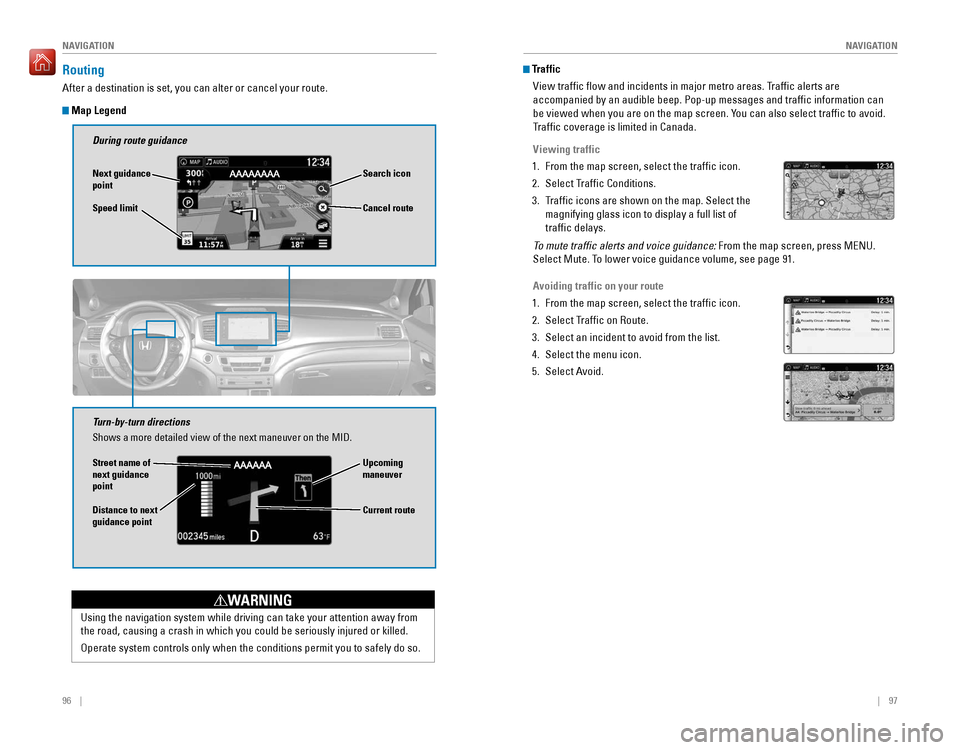
96 || 97
NAVIGATION
NAVIGATION
Routing
After a destination is set, you can alter or cancel your route.
Map Legend
During route guidance
Next guidance
point
Speed limit Search icon
Turn-by-turn directions
Shows a more detailed view of the next maneuver on the MID.
Upcoming
maneuver
Distance to next
guidance point Current route
Cancel route
Using the navigation system while driving can take your attention away f\
rom
the road, causing a crash in which you could be seriously injured or kil\
led.
Operate system controls only when the conditions permit you to safely do\
so.
WARNING
Street name of
next guidance
point
Traffic
View traffic flow and incidents in major metro areas. Traffic alerts are
accompanied by an audible beep. Pop-up messages and traffic informatio\
n can
be viewed when you are on the map screen. You can also select traffic to avoid.
Traffic coverage is limited in Canada.
Viewing traffic
1. From the map screen, select the traffic icon.
2. Select Traffic Conditions.
3. Traffic icons are shown on the map. Select the
magnifying glass icon to display a full list of
traffic delays.
To mute traffic alerts and voice guidance: From the map screen, press MENU.
Select Mute. To lower voice guidance volume, see page 91.
Avoiding traffic on your route
1. From the map screen, select the traffic icon.
2. Select Traffic on Route.
3. Select an incident to avoid from the list.
4. Select the menu icon.
5. Select Avoid.
Page 61 of 89
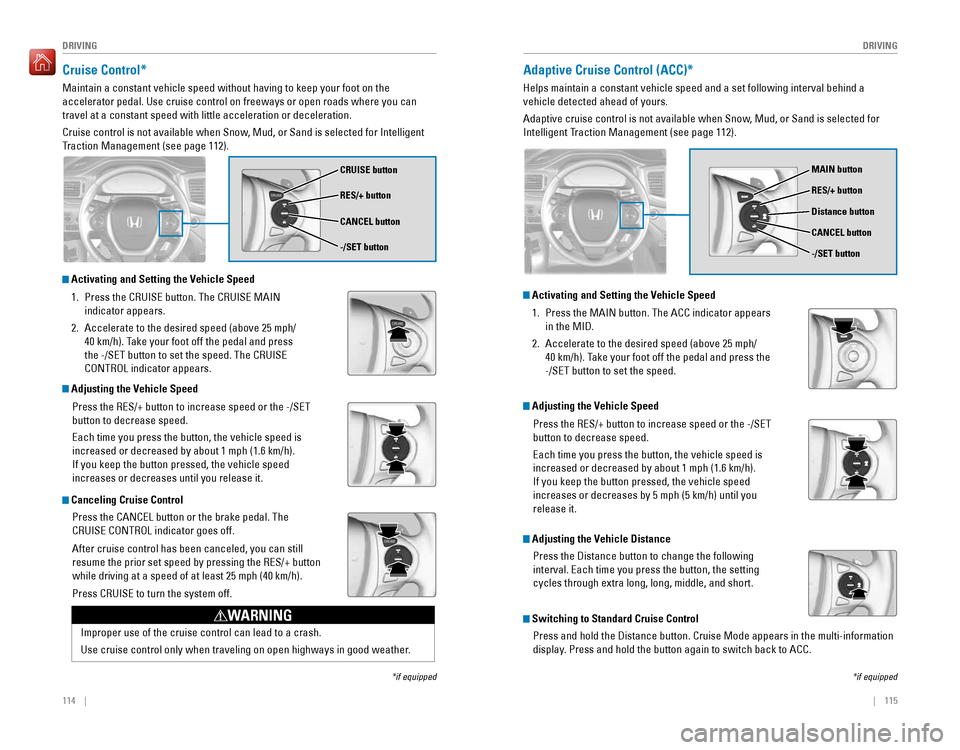
114 || 115
DRIVING
DRIVING
Cruise Control*
Maintain a constant vehicle speed without having to keep your foot on th\
e
accelerator pedal. Use cruise control on freeways or open roads where yo\
u can
travel at a constant speed with little acceleration or deceleration.
Cruise control is not available when Snow, Mud, or Sand is selected for Intelligent
Traction Management (see page 112).
Improper use of the cruise control can lead to a crash.
Use cruise control only when traveling on open highways in good weather.
WARNING
CRUISE
CRUISE button
RES/+ button
-/SET button CANCEL button
Adjusting the Vehicle SpeedPress the RES/+ button to increase speed or the -/SET
button to decrease speed.
Each time you press the button, the vehicle speed is
increased or decreased by about 1 mph (1.6 km/h).
If you keep the button pressed, the vehicle speed
increases or decreases until you release it.
Canceling Cruise ControlPress the CANCEL button or the brake pedal. The
CRUISE CONTROL indicator goes off.
After cruise control has been canceled, you can still
resume the prior set speed by pressing the RES/+ button
while driving at a speed of at least 25 mph (40 km/h).
Press CRUISE to turn the system off.
CRUISE
*if equipped
Adaptive Cruise Control (ACC)*
Helps maintain a constant vehicle speed and a set following interval beh\
ind a
vehicle detected ahead of yours.
Adaptive cruise control is not available when Snow, Mud, or Sand is selected for
Intelligent Traction Management (see page 112).
Activating and Setting the Vehicle Speed
1. Press the MAIN button. The ACC indicator appears
in the MID.
2. Accelerate to the desired speed (above 25 mph/
40 km/h). Take your foot off the pedal and press the
-/SET button to set the speed.
Adjusting the Vehicle Speed
Press the RES/+ button to increase speed or the -/SET
button to decrease speed.
Each time you press the button, the vehicle speed is
increased or decreased by about 1 mph (1.6 km/h).
If you keep the button pressed, the vehicle speed
increases or decreases by 5 mph (5 km/h) until you
release it.
Adjusting the Vehicle DistancePress the Distance button to change the following
interval. Each time you press the button, the setting
cycles through extra long, long, middle, and short.
Switching to Standard Cruise ControlPress and hold the Distance button. Cruise Mode appears in the multi-inf\
ormation
display. Press and hold the button again to switch back to ACC.
MAIN button
RES/+ button
CANCEL button
-/SET button
Distance button
Activating and Setting the Vehicle Speed
1. Press the CRUISE button. The CRUISE MAIN
indicator appears.
2. Accelerate to the desired speed (above 25 mph/
40 km/h). Take your foot off the pedal and press
the -/SET button to set the speed. The CRUISE
CONTROL indicator appears. CRUISE
*if equipped
Page 62 of 89
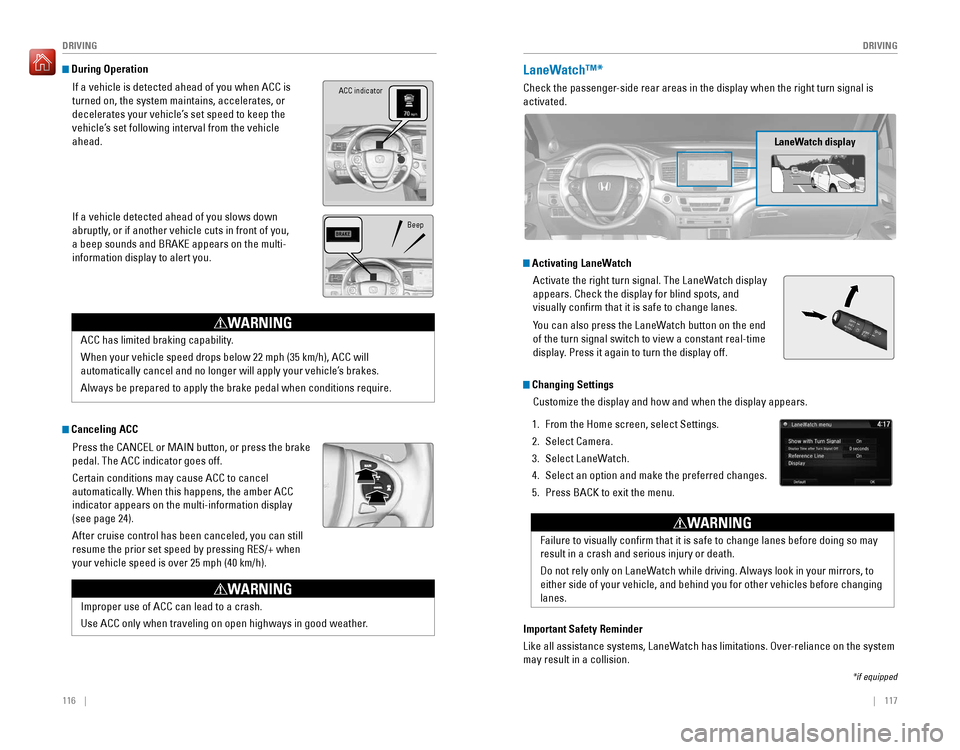
116 || 117
DRIVING
DRIVING
During Operation
If a vehicle is detected ahead of you when ACC is
turned on, the system maintains, accelerates, or
decelerates your vehicle’s set speed to keep the
vehicle’s set following interval from the vehicle
ahead.
If a vehicle detected ahead of you slows down
abruptly, or if another vehicle cuts in front of you,
a beep sounds and BRAKE appears on the multi-
information display to alert you.
ACC has limited braking capability.
When your vehicle speed drops below 22 mph (35 km/h), ACC will
automatically cancel and no longer will apply your vehicle’s brakes.
Always be prepared to apply the brake pedal when conditions require.
WARNING
Canceling ACCPress the CANCEL or MAIN button, or press the brake
pedal. The ACC indicator goes off.
Certain conditions may cause ACC to cancel
automatically. When this happens, the amber ACC
indicator appears on the multi-information display
(see page 24).
After cruise control has been canceled, you can still
resume the prior set speed by pressing RES/+ when
your vehicle speed is over 25 mph (40 km/h).
Improper use of ACC can lead to a crash.
Use ACC only when traveling on open highways in good weather.
WARNING
Beep
ACC indicator
LaneWatch™*
Check the passenger-side rear areas in the display when the right turn signal is
activated.
LaneWatch display
Activating LaneWatchActivate the right turn signal. The LaneWatch display
appears. Check the display for blind spots, and
visually confirm that it is safe to change lanes.
You can also press the LaneWatch button on the end
of the turn signal switch to view a constant real-time
display. Press it again to turn the display off.
*if equipped
Failure to visually confirm that it is safe to change lanes before doi\
ng so may
result in a crash and serious injury or death.
Do not rely only on LaneWatch while driving. Always look in your mirrors, to
either side of your vehicle, and behind you for other vehicles before ch\
anging
lanes.
WARNING
Important Safety Reminder
Like all assistance systems, LaneWatch has limitations. Over-reliance on the system
may result in a collision.
Changing SettingsCustomize the display and how and when the display appears.
1. From the Home screen, select Settings.
2. Select Camera.
3. Select LaneWatch.
4. Select an option and make the preferred changes.
5. Press BACK to exit the menu.
Page 64 of 89
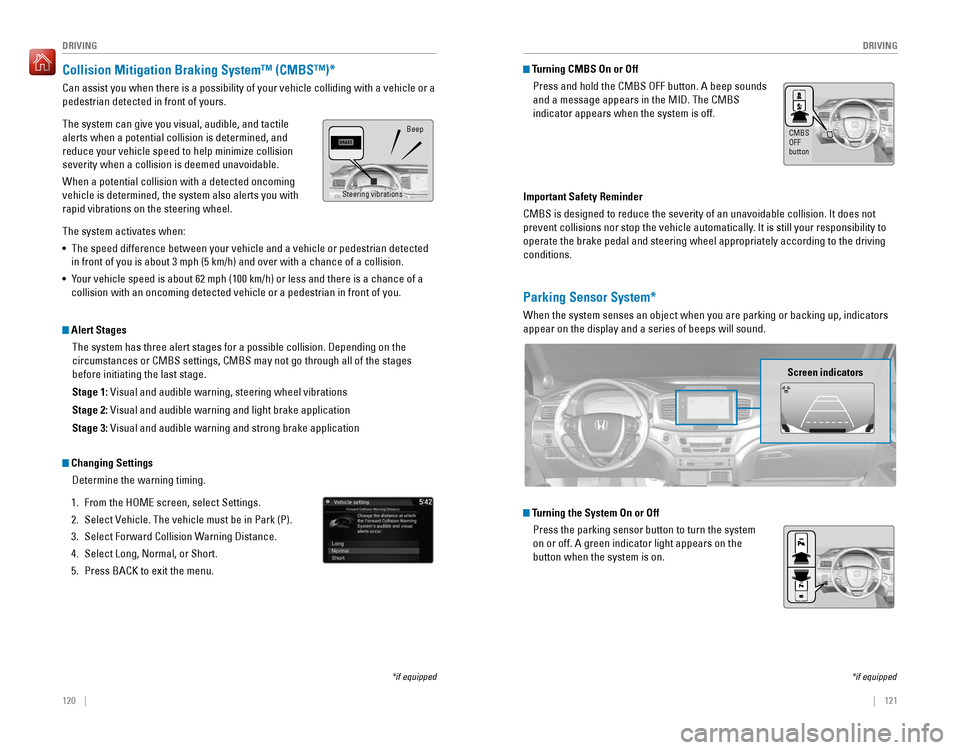
120 || 121
DRIVING
DRIVING
Collision Mitigation Braking System™ (CMBS™)*
Can assist you when there is a possibility of your vehicle colliding wit\
h a vehicle or a
pedestrian detected in front of yours.
The system can give you visual, audible, and tactile
alerts when a potential collision is determined, and
reduce your vehicle speed to help minimize collision
severity when a collision is deemed unavoidable.
When a potential collision with a detected oncoming
vehicle is determined, the system also alerts you with
rapid vibrations on the steering wheel.
The system activates when:
• The speed difference between your vehicle and a vehicle or pedestrian de\
tected
in front of you is about 3 mph (5 km/h) and over with a chance of a co\
llision.
• Your vehicle speed is about 62 mph (100 km/h) or less and there is a ch\
ance of a
collision with an oncoming detected vehicle or a pedestrian in front of \
you.
Changing Settings
Determine the warning timing.
1. From the HOME screen, select Settings.
2. Select Vehicle. The vehicle must be in Park (P).
3. Select Forward Collision Warning Distance.
4. Select Long, Normal, or Short.
5. Press BACK to exit the menu.
*if equipped
Alert StagesThe system has three alert stages for a possible collision. Depending on\
the
circumstances or CMBS settings, CMBS may not go through all of the stage\
s
before initiating the last stage.
Stage 1: Visual and audible warning, steering wheel vibrations
Stage 2: Visual and audible warning and light brake application
Stage 3: Visual and audible warning and strong brake application
Beep
Steering vibrationsImportant Safety Reminder
CMBS is designed to reduce the severity of an unavoidable collision. It \
does not
prevent collisions nor stop the vehicle automatically. It is still your responsibility to
operate the brake pedal and steering wheel appropriately according to th\
e driving
conditions.
Turning CMBS On or OffPress and hold the CMBS OFF button. A beep sounds
and a message appears in the MID. The CMBS
indicator appears when the system is off.
CMBS OFF
button
Parking Sensor System*
When the system senses an object when you are parking or backing up, ind\
icators
appear on the display and a series of beeps will sound.
Turning the System On or OffPress the parking sensor button to turn the system
on or off. A green indicator light appears on the
button when the system is on.
Screen indicators
*if equipped
Page 66 of 89

124 || 125
DRIVING
DRIVING
Multi-View Rear Camera*
When you shift into Reverse (R), a real-time image of the area behind \
your vehicle is
shown in the display, along with helpful parking guidelines.
Wide view Normal viewTop down view
Press the selector knob (color audio system) or touch icons on the scr\
een (touchscreen) to toggle between views.
Changing Settings
Turn the guidelines on or off. Use the interface dial to make and enter s\
elections.
Models with color audio system
1. Press the MENU/CLOCK button.
2. Select Settings.
3. Select Rear Camera.
4. Select Camera Guidelines.
5. Select On or Off.
6. Press the Back button to exit the menus.
*if equipped The rear camera view is restricted. You cannot see the corner ends of the bumper or what is
underneath the bumper. Its unique lens also makes objects appear closer or farther than they \
actually are.
Visually confirm that it is safe to drive before backing up. Certain c\
onditions (such as weather,
lighting, and high temperatures) may also restrict the rear view. Do not rely on the rearview display,
which does not give you all information about conditions at the rear of \
your vehicle.
Models with touchscreen
1. From the HOME screen, select Settings.
2. Select Camera.
3. Select one of the options.
Fixed Guidelines: Guidelines appear when you
change the gear to Reverse. Select On or Off.
Dynamic Guidelines: Guidelines move as you turn
the steering wheel. Select On or Off.
4. Press BACK to exit the menu.
Page 70 of 89
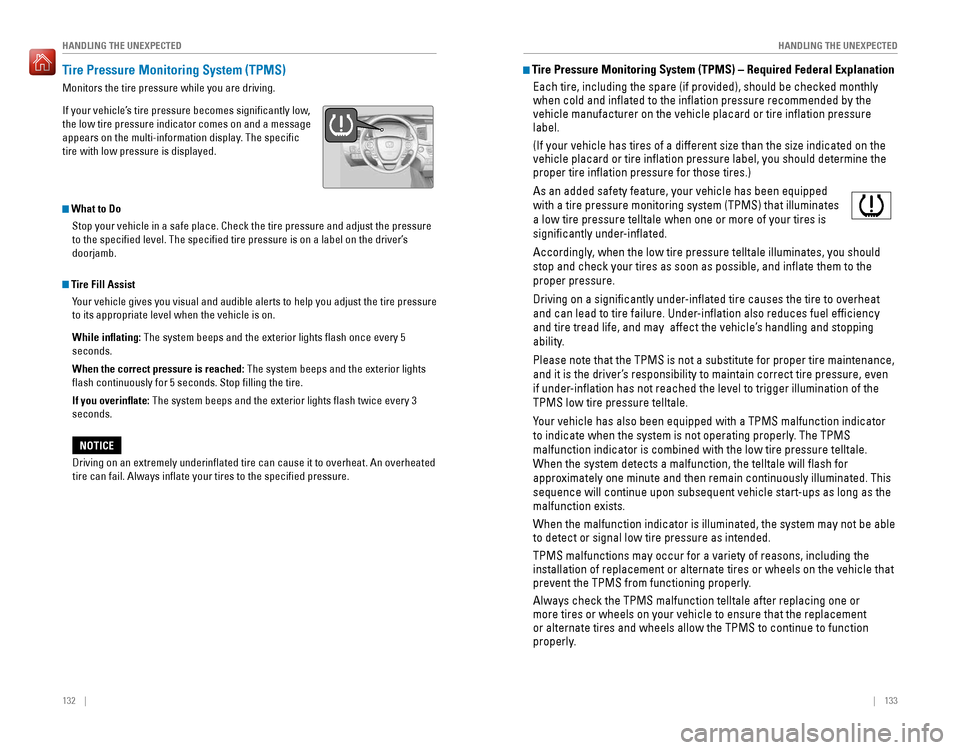
132 || 133
HANDLING THE UNEXPECTED
HANDLING THE UNEXPECTED
Driving on an extremely underinflated tire can cause it to overheat. A\
n overheated
tire can fail. Always inflate your tires to the specified pressure.
NOTICE
Tire Pressure Monitoring System (TPMS)
Monitors the tire pressure while you are driving.
If your vehicle’s tire pressure becomes significantly low,
the low tire pressure indicator comes on and a message
appears on the multi-information display. The specific
tire with low pressure is displayed.
What to Do
Stop your vehicle in a safe place. Check the tire pressure and adjust th\
e pressure
to the specified level. The specified tire pressure is on a label on\
the driver’s
doorjamb.
Tire Fill AssistYour vehicle gives you visual and audible alerts to help you adjust the t\
ire pressure
to its appropriate level when the vehicle is on.
While inflating: The system beeps and the exterior lights flash once every 5
seconds.
When the correct pressure is reached: The system beeps and the exterior lights
flash continuously for 5 seconds. Stop filling the tire.
If you overinflate: The system beeps and the exterior lights flash twice every 3
seconds.
Tire Pressure Monitoring System (TPMS) – Required Federal Explanatio\
nEach tire, including the spare (if provided), should be checked monthl\
y
when cold and inflated to the inflation pressure recommended by the \
vehicle manufacturer on the vehicle placard or tire inflation pressure\
label.
(If your vehicle has tires of a different size than the size indicated \
on the
vehicle placard or tire inflation pressure label, you should determine\
the
proper tire inflation pressure for those tires.)
As an added safety feature, your vehicle has been equipped
with a tire pressure monitoring system (TPMS) that illuminates
a low tire pressure telltale when one or more of your tires is
significantly under-inflated.
Accordingly, when the low tire pressure telltale illuminates, you should
stop and check your tires as soon as possible, and inflate them to the\
proper pressure.
Driving on a significantly under-inflated tire causes the tire to overheat
and can lead to tire failure. Under-inflation also reduces fuel efficiency
and tire tread life, and may affect the vehicle’s handling and stopping
ability.
Please note that the TPMS is not a substitute for proper tire maintenanc\
e,
and it is the driver’s responsibility to maintain correct tire pressure, even
if under-inflation has not reached the level to trigger illumination of the
TPMS low tire pressure telltale.
Your vehicle has also been equipped with a TPMS malfunction indicator
to indicate when the system is not operating properly. The TPMS
malfunction indicator is combined with the low tire pressure telltale.
When the system detects a malfunction, the telltale will flash for
approximately one minute and then remain continuously illuminated. This \
sequence will continue upon subsequent vehicle start-ups as long as the \
malfunction exists.
When the malfunction indicator is illuminated, the system may not be abl\
e
to detect or signal low tire pressure as intended.
TPMS malfunctions may occur for a variety of reasons, including the
installation of replacement or alternate tires or wheels on the vehicle \
that
prevent the TPMS from functioning properly.
Always check the TPMS malfunction telltale after replacing one or
more tires or wheels on your vehicle to ensure that the replacement
or alternate tires and wheels allow the TPMS to continue to function
properly.
Page 75 of 89

142 || 143
MAINTENANCE
MAINTENANCE
Safety Precautions
Some of the most important safety precautions are listed below; however, we cannot
warn you of every conceivable hazard that can arise in performing mainte\
nance.
Only you can decide whether or not you should perform a given task.
Maintenance Safety
• To reduce the possibility of fire or explosion, keep cigarettes, sparks\
, and flames
away from the battery and all fuel-related parts.
• Never leave rags, towels, or other flammable objects under the hood.
• To clean parts, use a commercially available degreaser or parts cleaner, not
gasoline.
• Wear eye protection and protective clothing when working with the battery\
or
compressed air.
• Do not run the engine in confined spaces where carbon monoxide gas can\
accumulate.
Vehicle Safety
• The vehicle must be stationary, and parked on level ground with the parking
brake set and the engine off.
• Be aware that hot parts can burn you.
• Be aware that moving parts can injure you.
• Do not open the hood while the Auto Idle Stop function* is activated.
Improperly maintaining this vehicle or failing to correct a problem befo\
re
driving can cause a crash in which you can be seriously hurt or killed. \
Always follow the inspection and maintenance recommendations according
to the schedules in this guide.
WARNING
Failure to properly follow maintenance instructions and precautions can \
cause you to be seriously hurt or killed.
Always follow the procedures and precautions in this guide.
WARNING
Learn about basic maintenance that you can perform on the vehicle yourse\
lf, as well
as information about how to best maintain the vehicle.
MAINTENANCE
*if equipped
Maintenance Minder™
When maintenance is due, the system message indicator comes on and a mes\
sage
appears on the display every time you turn the vehicle on. See page 144 to check
what maintenance is due indicated by the codes that appear.
Press the Info (p/q) button on the steering wheel to change displays.
System message indicator
Main
items Sub items
Maintenance Minder message
• Independent of the Maintenance Minder information, replace the brake fl\
uid
every 3 years.
• Inspect idle speed every 160,000 miles (256,000 km).
• Adjust the valves during services A, B, 1, 2, or 3 if they are noisy.
U.S. models
Maintenance, replacement, or repair of emissions control devices and sys\
tems
may be done by any automotive repair establishment or individuals using \
parts
that are certified to EPA standards.
According to state and federal regulations, failure to perform maintenan\
ce on the
maintenance main items marked with # will not void your emissions warranties.
However, all maintenance services should be performed in accordance with the
intervals indicated by the multi-information display.
Page 76 of 89
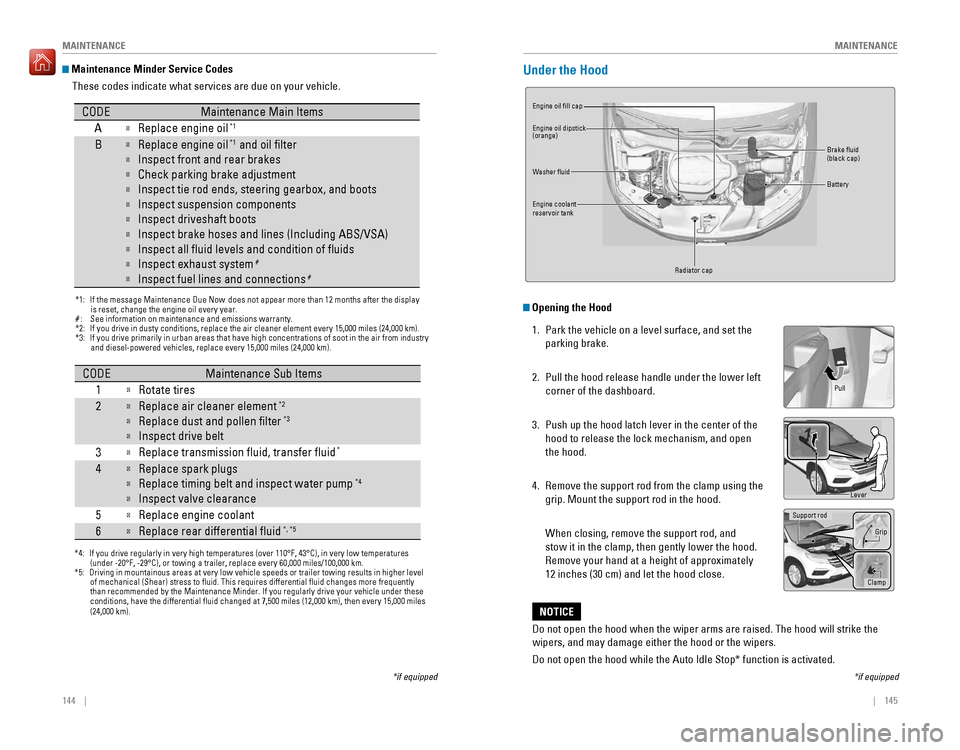
144 || 145
MAINTENANCE
MAINTENANCE
Maintenance Minder Service Codes
These codes indicate what services are due on your vehicle.
*1: If the message Maintenance Due Now does not appear more than 12 months after the display
is reset, change the engine oil every year.
#: See information on maintenance and emissions warranty.
*2: If you drive in dusty conditions, replace the air cleaner element every \
15,000 miles (24,000 km).
*3:
If you drive primarily in urban areas that have high concentrations of s\
oot in the air from industryand diesel-powered vehicles, replace every 15,000 miles (24,000 km).
CODEMaintenance Main Items
A
�Replace engine oi l*1
B�Replace engine oil*1 and oil �lter
�Inspect front and rear brakes
�Check parking brake adjustment
�Inspect tie rod ends, steering gearbox, and boots
�Inspect suspension components
�Inspect driveshaft boots
�Inspect brake hoses and lines (Including ABS/VSA)
�Inspect all �uid levels and condition of �uids
�Inspect exhaust system#
�Inspect fuel lines and connection s#
*4:If you drive regularly in very high temperatures (over 110°F, 43°\
C), in very low temperatures
(under -20°F, -29°C), or towing a trailer, replace every 60,000 \
miles/100,000 km.
*5:Driving in mountainous areas at very low vehicle speeds or trailer towin\
g results in higher level
of mechanical (Shear) stress to �uid. This requires differential �\
uid changes more frequently
than recommended by the Maintenance Minder. If you regularly drive your \
vehicle under these
conditions, have the differential �uid changed at 7,500 miles (12,00\
0 km), then every 15,000 miles
(24,000 km).
CODEMaintenance Sub Items
1
�Rotate tires
2�Replace air cleaner element*2
�Replace dust and pollen �lter*3
�Inspect drive belt
3
�Replace transmission �uid, transfer �uid
4�Replace spark plug s
�Replace timing belt and inspect water pump*4
�Inspect valve clearance
5
�Replace engine coolant
6�Replace rear differential �ui d*, *5
*
*if equipped
Under the Hood
Opening the Hood
1. Park the vehicle on a level surface, and set the
parking brake.
2. Pull the hood release handle under the lower left
corner of the dashboard.
3. Push up the hood latch lever in the center of the
hood to release the lock mechanism, and open
the hood.
4. Remove the support rod from the clamp using the
grip. Mount the support rod in the hood.
When closing, remove the support rod, and
stow it in the clamp, then gently lower the hood.
Remove your hand at a height of approximately
12 inches (30 cm) and let the hood close.
Brake fluid (black cap)
Battery
Engine oil fill cap
Lever
Support rod Grip
Clamp
Pull
Washer fluid
Engine coolant
reservoir tank Engine oil dipstick
(orange)
Radiator cap
Do not open the hood when the wiper arms are raised. The hood will strik\
e the
wipers, and may damage either the hood or the wipers.
Do not open the hood while the Auto Idle Stop* function is activated.
NOTICE
*if equipped
Page 79 of 89
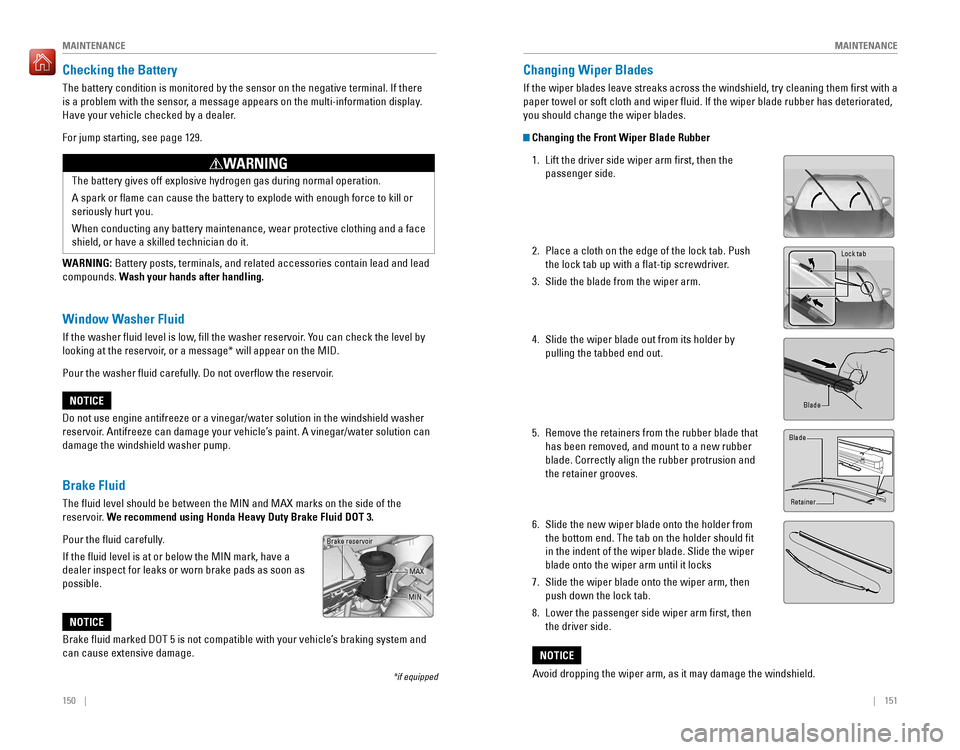
150 || 151
MAINTENANCE
MAINTENANCE
Checking the Battery
The battery condition is monitored by the sensor on the negative termina\
l. If there
is a problem with the sensor, a message appears on the multi-information display.
Have your vehicle checked by a dealer.
For jump starting, see page 129.
The battery gives off explosive hydrogen gas during normal operation.
A spark or flame can cause the battery to explode with enough force to\
kill or
seriously hurt you.
When conducting any battery maintenance, wear protective clothing and a \
face
shield, or have a skilled technician do it.
WARNING
WARNING: Battery posts, terminals, and related accessories contain lead and lead\
compounds. Wash your hands after handling.
Window Washer Fluid
If the washer fluid level is low, fill the washer reservoir. You can check the level by
looking at the reservoir, or a message* will appear on the MID.
Pour the washer fluid carefully. Do not overflow the reservoir.
Do not use engine antifreeze or a vinegar/water solution in the windshie\
ld washer
reservoir. Antifreeze can damage your vehicle’s paint. A vinegar/water solution can
damage the windshield washer pump.
NOTICE
Brake Fluid
The fluid level should be between the MIN and MAX marks on the side of\
the
reservoir. We recommend using Honda Heavy Duty Brake Fluid DOT 3.
Pour the fluid carefully.
If the fluid level is at or below the MIN mark, have a
dealer inspect for leaks or worn brake pads as soon as
possible.
Brake fluid marked DOT 5 is not compatible with your vehicle’s braking system and
can cause extensive damage.
NOTICE
*if equipped
Brake reservoir MAX
MIN
Changing Wiper Blades
If the wiper blades leave streaks across the windshield, try cleaning th\
em first with a
paper towel or soft cloth and wiper fluid. If the wiper blade rubber h\
as deteriorated,
you should change the wiper blades.
Changing the Front Wiper Blade Rubber
1. Lift the driver side wiper arm first, then the
passenger side.
2. Place a cloth on the edge of the lock tab. Push
the lock tab up with a flat-tip screwdriver.
3. Slide the blade from the wiper arm.
4. Slide the wiper blade out from its holder by
pulling the tabbed end out.
5. Remove the retainers from the rubber blade that
has been removed, and mount to a new rubber
blade. Correctly align the rubber protrusion and
the retainer grooves.
6. Slide the new wiper blade onto the holder from
the bottom end. The tab on the holder should fit
in the indent of the wiper blade. Slide the wiper
blade onto the wiper arm until it locks
7. Slide the wiper blade onto the wiper arm, then
push down the lock tab.
8. Lower the passenger side wiper arm first, then
the driver side.
Lock tab
Blade
Retainer
Avoid dropping the wiper arm, as it may damage the windshield.
NOTICE
Blade
Page 88 of 89
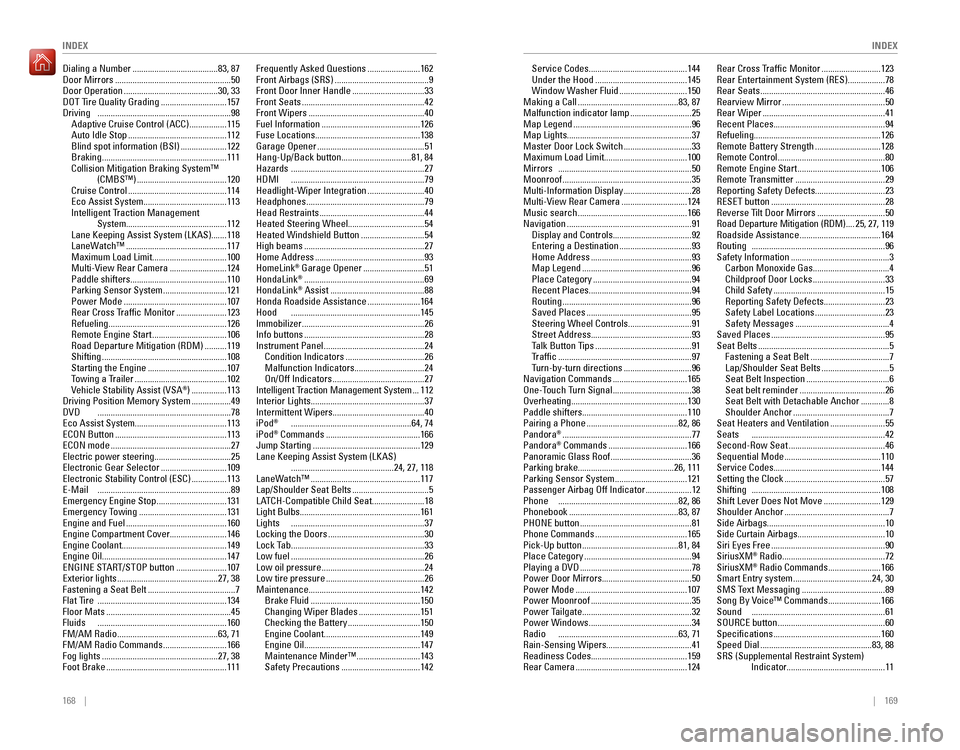
168 || 169
INDEX
INDEX
Dialing a Number .......................................83, 87
Door Mirrors .....................................................50
Door Operation ...........................................30, 33
DOT Tire Quality Grading ..............................157Driving .............................................................98
Adaptive Cruise Control (ACC) .................115
Auto Idle Stop .............................................112
Blind spot information (BSI) .....................122
Braking .........................................................111
Collision Mitigation Braking System™ (CMBS™)
.........................................120
Cruise Control .............................................114
Eco Assist System ......................................113
Intelligent Traction Management System .............................................. 112
Lane Keeping Assist System (LKAS)
.......118
LaneWatch™ ..............................................117
Maximum Load Limit ..................................100
Multi-View Rear Camera ..........................124
Paddle shifters ............................................110
Parking Sensor System .............................121
Power Mode ...............................................107
Rear Cross Traffic Monitor .......................123
Refueling ......................................................126
Remote Engine Start ..................................106
Road Departure Mitigation (RDM) ..........119
Shifting .........................................................108
Starting the Engine ....................................107
Towing a Trailer ..........................................102
Vehicle Stability Assist (VSA®) ................113
Driving Position Memory System ..................49DVD .............................................................78
Eco Assist System .......................................... 113
ECON Button
...................................................113
ECON mode .......................................................27
Electric power steering ...................................25
Electronic Gear Selector
..............................109
Electronic Stability Control (ESC) ................113E-Mail .............................................................89
Emergency Engine Stop ................................131
Emergency Towing ........................................131
Engine and Fuel ..............................................160
Engine Compartment Cover ..........................146
Engine Coolant ................................................ 149
Engine Oil ......................................................... 147
ENGINE START/STOP button
.......................107
Exterior lights ..............................................27, 38
Fastening a Seat Belt ........................................7Flat Tire ...........................................................134
Floor Mats .........................................................45Fluids ...........................................................160
FM/AM Radio ..............................................63, 71
FM/AM Radio Commands .............................166
Fog lights .....................................................27, 38
Foot Brake .......................................................111 Frequently Asked Questions
........................162
Front Airbags (SRS) ...........................................9
Front Door Inner Handle .................................33
Front Seats ........................................................42
Front Wipers .....................................................40
Fuel Information .............................................126
Fuse Locations ................................................ 138
Garage Opener
.................................................51
Hang-Up/Back button ................................81, 84
Hazards .............................................................27HDMI .............................................................79
Headlight-Wiper Integration ..........................40
Headphones ......................................................79
Head Restraints ................................................44
Heated Steering Wheel ...................................54
Heated Windshield Button
.............................54
High beams .......................................................27
Home Address ..................................................93
HomeLink® Garage Opener ............................51
HondaLink® .......................................................69
HondaLink® Assist ...........................................88
Honda Roadside Assistance ........................164Hood ...........................................................145
Immobilizer ........................................................26
Info buttons .......................................................28
Instrument Panel ..............................................24
Condition Indicators ....................................26
Malfunction Indicators ................................24
On/Off Indicators ..........................................27
Intelligent Traction Management System ...112
Interior Lights .................................................... 37
Intermittent Wipers .......................................... 40
iPod
® .......................................................64, 74
iPod® Commands ...........................................166
Jump Starting .................................................129
Lane Keeping Assist System (LKAS)
...............................................24, 27, 118
LaneWatch™ ..................................................117
Lap/Shoulder Seat Belts ...................................5
LATCH-Compatible Child Seat ........................18
Light Bulbs ....................................................... 161
Lights .............................................................37
Locking the Doors ............................................30
Lock Tab .............................................................33Low fuel .............................................................26
Low oil pressure ...............................................24
Low tire pressure .............................................26
Maintenance ................................................... 142
Brake Fluid
..................................................150
Changing Wiper Blades ............................151
Checking the Battery .................................150
Engine Coolant ............................................149
Engine Oil .....................................................147
Maintenance Minder™ .............................143
Safety Precautions ....................................142 Service Codes
.............................................144
Under the Hood ..........................................145
Window Washer Fluid ...............................150
Making a Call ..............................................83, 87
Malfunction indicator lamp ............................25
Map Legend ......................................................96
Map Lights ......................................................... 37
Master Door Lock Switch
...............................33
Maximum Load Limit ...................................... 100
Mirrors .............................................................50
Moonroof ...........................................................35
Multi-Information Display ...............................28
Multi-View Rear Camera ..............................124
Music search ..................................................166
Navigation .........................................................91
Display and Controls ....................................92
Entering a Destination .................................93
Home Address ..............................................93
Map Legend ..................................................96
Place Category .............................................94
Recent Places ...............................................94
Routing ...........................................................96
Saved Places ................................................95
Steering Wheel Controls .............................91
Street Address ..............................................93
Talk Button Tips ............................................91Traffic .............................................................97
Turn-by-turn directions ...............................96
Navigation Commands ..................................165
One-Touch Turn Signal ....................................38
Overheating ..................................................... 130
Paddle shifters ................................................ 110
Pairing a Phone
..........................................82, 86
Pandora® ...........................................................77
Pandora® Commands ....................................166
Panoramic Glass Roof .....................................36
Parking brake ............................................ 26, 111
Parking Sensor System
.................................121
Passenger Airbag Off Indicator .....................12Phone .......................................................82, 86
Phonebook ..................................................83, 87PHONE button ...................................................81
Phone Commands ..........................................165
Pick-Up button ............................................81, 84
Place Category .................................................94
Playing a DVD ...................................................78
Power Door Mirrors ......................................... 50
Power Mode
...................................................107
Power Moonroof ..............................................35
Power Tailgate ..................................................32
Power Windows ...............................................34Radio .......................................................63, 71
Rain-Sensing Wipers ....................................... 41
Readiness Codes ............................................ 159
Rear Camera
...................................................124 Rear Cross Traffic Monitor
...........................123
Rear Entertainment System (RES) .................78
Rear Seats .........................................................46
Rearview Mirror ...............................................50
Rear Wiper ........................................................41
Recent Places ................................................... 94
Refueling .......................................................... 126
Remote Battery Strength
..............................128
Remote Control .................................................80
Remote Engine Start ......................................106
Remote Transmitter .........................................29
Reporting Safety Defects ................................23
RESET button
....................................................28
Reverse Tilt Door Mirrors ...............................50
Road Departure Mitigation (RDM) ....25, 27, 119
Roadside Assistance .....................................164Routing .............................................................96
Safety Information .............................................3
Carbon Monoxide Gas ...................................4
Childproof Door Locks .................................33
Child Safety ...................................................15
Reporting Safety Defects ............................23
Safety Label Locations ................................23
Safety Messages ...........................................4
Saved Places ....................................................95
Seat Belts ............................................................5
Fastening a Seat Belt ....................................7
Lap/Shoulder Seat Belts ...............................5
Seat Belt Inspection ......................................6
Seat belt reminder .......................................26
Seat Belt with Detachable Anchor .............8
Shoulder Anchor ............................................7
Seat Heaters and Ventilation .........................55Seats .............................................................42
Second-Row Seat ............................................46
Sequential Mode ............................................110
Service Codes ................................................. 144
Setting the Clock
..............................................57Shifting ...........................................................108
Shift Lever Does Not Move ..........................129
Shoulder Anchor ................................................7
Side Airbags ...................................................... 10
Side Curtain Airbags ........................................ 10
Siri Eyes Free
....................................................90
SiriusXM® Radio ...............................................72
SiriusXM® Radio Commands ........................166
Smart Entry system ....................................24, 30
SMS Text Messaging ......................................89
Song By Voice™ Commands ........................166Sound .............................................................61
SOURCE button .................................................60
Specifications .................................................160
Speed Dial ...................................................83, 88
SRS (Supplemental Restraint System) Indicator ............................................. 11